Northern Pulp produces NBSK (Northern Bleached Softwood Kraft) pulp. The long fibre of NBSK adds strength to products like paper towels and tissue paper. Because it is bleached it is used as a whitening agent. NBSK is highly valuable and becoming more so since there are fewer thermal chemical mills producing it.
Woodyard
Lumber from numerous woodlots and sawmills across Nova Scotia are transported to Northern Pulp and deposited in the woodyard.
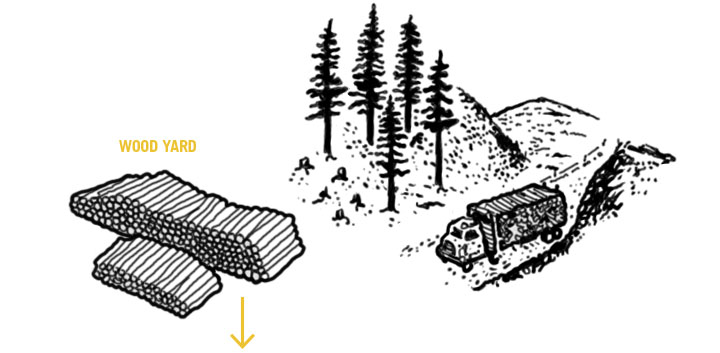
Debarking
The lumber passes through a barking drum – a revolving drum that loosens and removes bark by repeated impacts. Stripped bark is used for fuel, or to enrich soil.

Chipper
Lumber is ground into chips and deposited into a storage silo, first passing through screens to prevent oversized chips and undersized particles from passing.
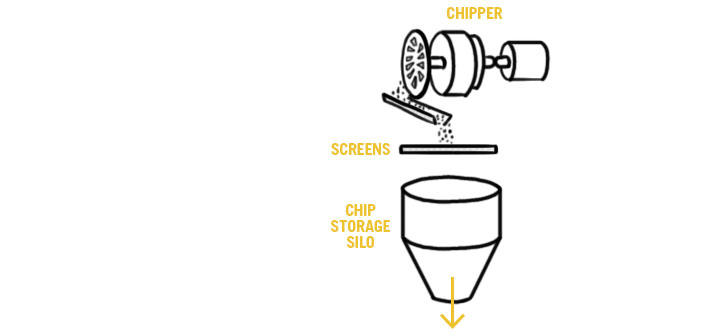
Digestor
Chips are fed into the digestor for ‘cooking’, where aqueous sodium hydroxide and sodium sulfide, under heat and pressure, break down the lignin holding the wood fibres together.
Chemical Recovery
The spent cooking liquor (black liquor) is routed to the chemical recovery area. The chemical recovery process involves concentrating weak black liquor, combusting organic compounds, reducing inorganic compounds, and reconstituting the cooking liquor so it can be re-used in the pulping process.
Blow Tank
After the wood chips have been ‘cooked,’ the contents of the digestor are discharged under pressure into a blow tank, where the chips disintegrate into fibres or ‘pulp.’
Recovery Furnace
The energy generated by burning the black liquor is recovered as steam for process requirements, such as cooking wood chips, heating and evaporating black liquor, preheating combustion air, and drying the pulp or paper products.
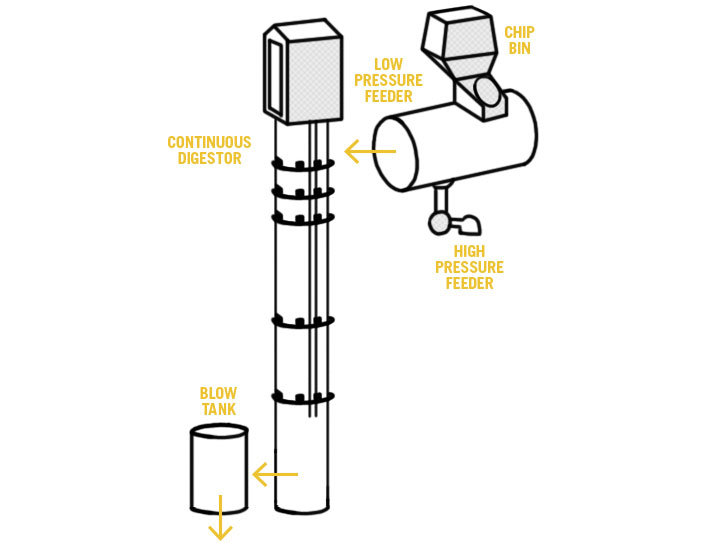
Washers
Pulp and spent cooking liquor (black liquor) are separated in a series of washers. The resultant unbleached pulp is placed in storage.
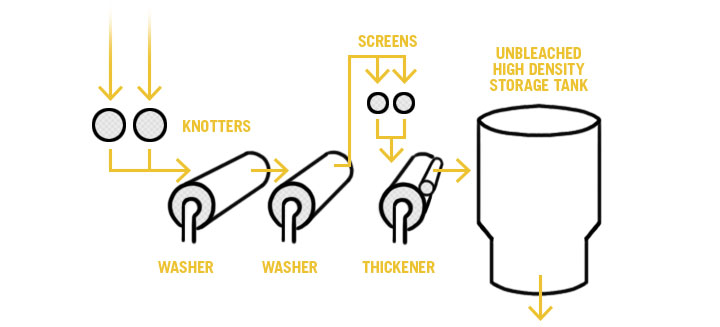
Bleach Plant
The bleaching process removes color from the pulp (due to residual lignin) by adding chemicals to the pulp in varying combinations, depending on the end use of the product. The chemicals are added to the pulp in stages in the bleaching towers. Spent bleaching chemicals are removed between each stage in the washers. Washer effluent is collected in the seal tanks and either re-used in other stages as wash water or sent to wastewater treatment. Up to 85% of the total effluent volume in a pulp mill is generated in the bleaching stage.
Wastewater Treatment
In an aerated pond, wastewater is treated through a combination of physical, biological and chemical processes. These ponds use aeration devices to add oxygen to the wastewater (normally surface turbine aerators or bottom aerators) and mix the contents of the pond, thereby enhancing the microbial activity. Boat Harbour is a classic example of this type of treatment. Due to low efficiency levels and the large surface required, the use of aerated lagoons has drastically diminished.
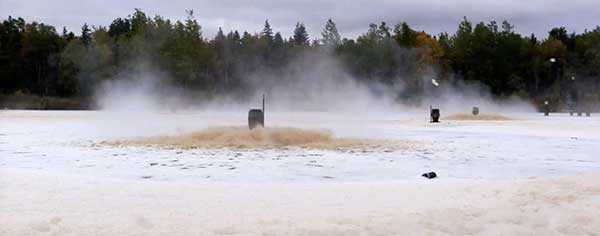
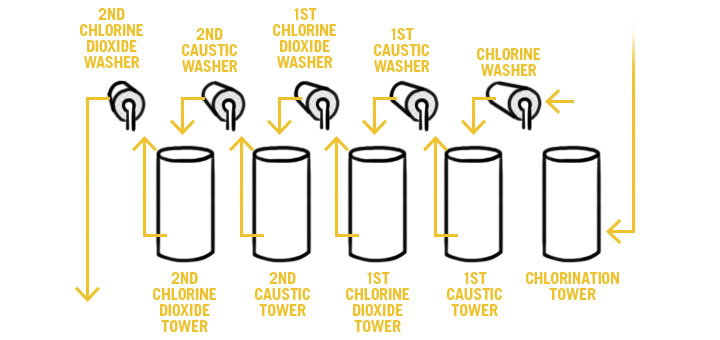
Pulp Machine
The pulp is processed into the stock used for papermaking. The pulp is taken from a storage chest, screened and refined (if necessary), and placed into a head box of the paper machine. From there, a slurry of pulp is created using water. The pulp slurry is put through a paper machine and then passed through a press section, where the water is drained and the sheet forming process begins. The paper sheet is then put through a dryer and a series of booths for coating and drying.


Warehouse and Shipping
The finished product goes through a calender (where the sheet is pressed to reduce thickness and smooth the surface) and is wound onto storage reels and prepared for transporting via truck and rail.

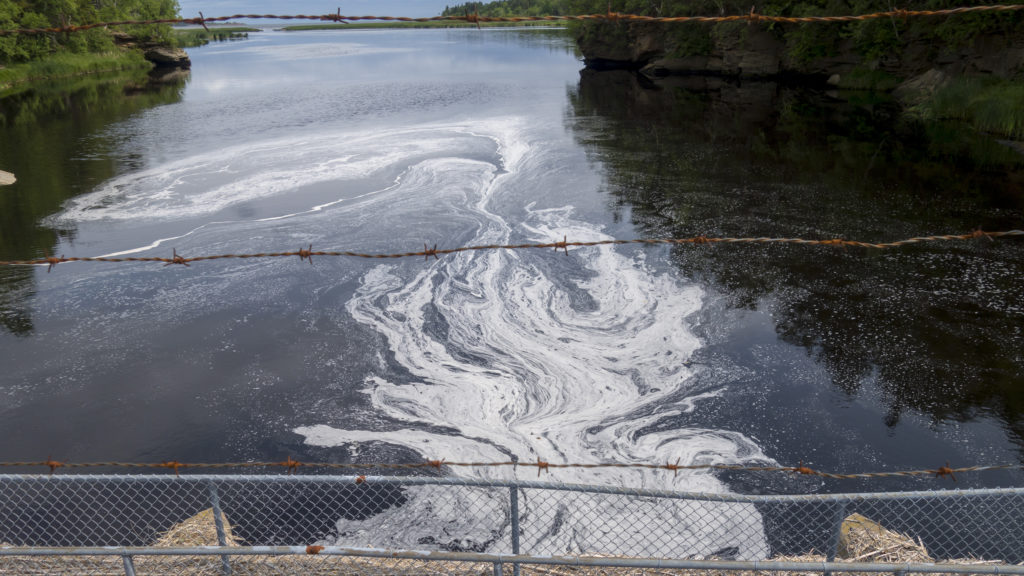 Effluent
Effluent
Effluent is defined by the United States Environmental Protection Agency as “wastewater – treated or untreated – that flows out of a treatment plant, sewer, or industrial outfall.” Generally, it refers to wastes discharged into surface waters. In the context of wastewater treatment plants, effluent that has been treated is sometimes called secondary effluent, or treated effluent. Effluent was not regulated until the early 1990s.
Paper manufacturing releases chlorinated lignosulfonic acids, chlorinated resin acids, chlorinated phenols (trichlorophenol, trichloroguicol, tetrachloroguicol, dichlorophenol, dichloroguicol, and pentachlorophenol), and chlorinated hydrocarbon into the effluent wastewater. These are the major contaminants formed in the effluent of pulp and paper mills. Some compounds in the effluents are resistant to biodegradation and can accumulate in the aquatic food chain.
In laboratory tests, mill effluent causes reproductive impairment in zooplankton, invertebrates (both being food for fish), and shellfish (Environment Canada, Environmental Effects Monitoring Report, Cycle One). Other studies show genetic damage and immune system reactions in fish (Easton et al. 1997, Genetic Toxicity of Pulp Mill Effluent on Juvenile Chinook Salmon (Onchorhynchus shawytscha) Using Flow Cytometry, Elsevier Science Ltd., Vol. 35, #2-3).
Sources:
- https://millwatch.ca/
- https://www.wonderopolis.org/wonder/how-do-you-make-paper-from-a-tree
- https://www.epa.gov/sites/production/files/2015-12/documents/pulpandpaper.pdf
- https://www.nap.edu/read/9458/chapter/9#134
- https://www.intechopen.com/books/biological-wastewater-treatment-and-resource-recovery/pulp-mill-wastewater-characteristics-and-treatment
- http://blog.pulpandpaper-technology.com/chemical-recovery-in-pulp-and-paper-industry/






